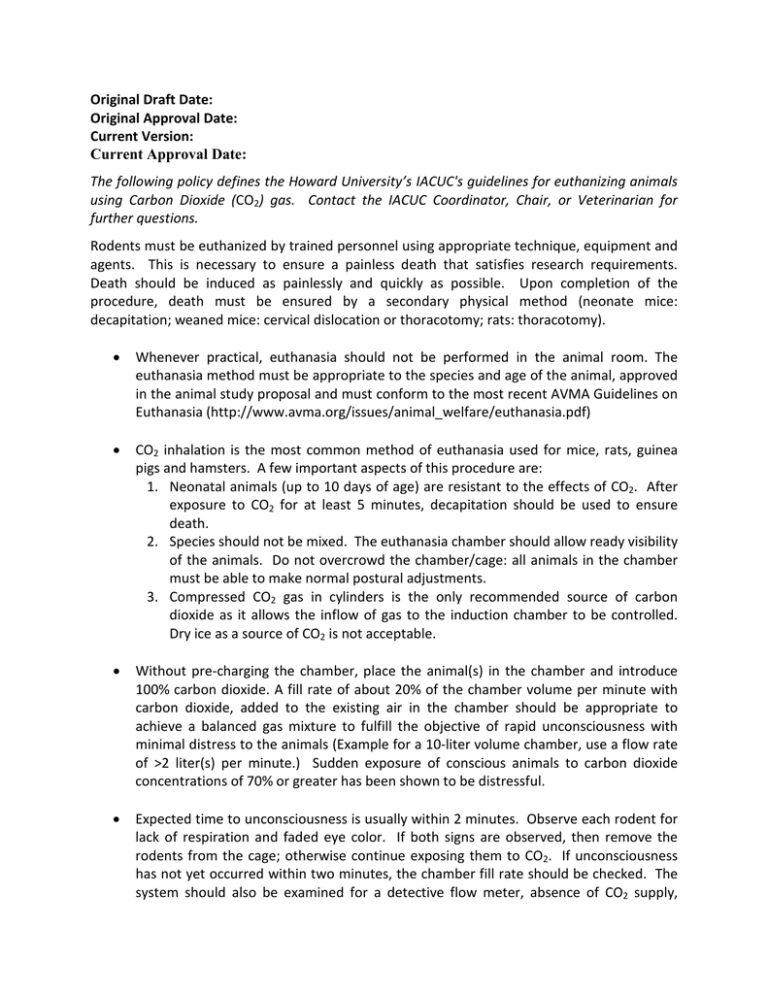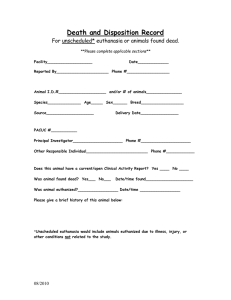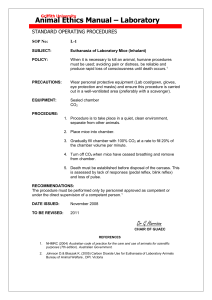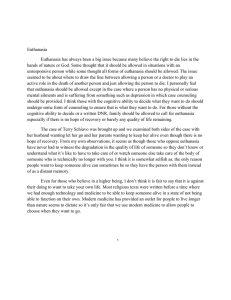Original Draft Date: Original Approval Date: Current Version: Current
advertisement

Original Draft Date: Original Approval Date: Current Version: Current Approval Date: The following policy defines the Howard University’s IACUC's guidelines for euthanizing animals using Carbon Dioxide (CO2) gas. Contact the IACUC Coordinator, Chair, or Veterinarian for further questions. Rodents must be euthanized by trained personnel using appropriate technique, equipment and agents. This is necessary to ensure a painless death that satisfies research requirements. Death should be induced as painlessly and quickly as possible. Upon completion of the procedure, death must be ensured by a secondary physical method (neonate mice: decapitation; weaned mice: cervical dislocation or thoracotomy; rats: thoracotomy). • Whenever practical, euthanasia should not be performed in the animal room. The euthanasia method must be appropriate to the species and age of the animal, approved in the animal study proposal and must conform to the most recent AVMA Guidelines on Euthanasia (http://www.avma.org/issues/animal_welfare/euthanasia.pdf) • CO2 inhalation is the most common method of euthanasia used for mice, rats, guinea pigs and hamsters. A few important aspects of this procedure are: 1. Neonatal animals (up to 10 days of age) are resistant to the effects of CO2. After exposure to CO2 for at least 5 minutes, decapitation should be used to ensure death. 2. Species should not be mixed. The euthanasia chamber should allow ready visibility of the animals. Do not overcrowd the chamber/cage: all animals in the chamber must be able to make normal postural adjustments. 3. Compressed CO2 gas in cylinders is the only recommended source of carbon dioxide as it allows the inflow of gas to the induction chamber to be controlled. Dry ice as a source of CO2 is not acceptable. • Without pre-charging the chamber, place the animal(s) in the chamber and introduce 100% carbon dioxide. A fill rate of about 20% of the chamber volume per minute with carbon dioxide, added to the existing air in the chamber should be appropriate to achieve a balanced gas mixture to fulfill the objective of rapid unconsciousness with minimal distress to the animals (Example for a 10-liter volume chamber, use a flow rate of >2 liter(s) per minute.) Sudden exposure of conscious animals to carbon dioxide concentrations of 70% or greater has been shown to be distressful. • Expected time to unconsciousness is usually within 2 minutes. Observe each rodent for lack of respiration and faded eye color. If both signs are observed, then remove the rodents from the cage; otherwise continue exposing them to CO2. If unconsciousness has not yet occurred within two minutes, the chamber fill rate should be checked. The system should also be examined for a detective flow meter, absence of CO2 supply, and/or leaks. Appropriate CO2 concentrations and exposure times will prevent unintended recovery. Again, death must be ensured after euthanasia and prior to disposal. • Ensure that death has occurred through: loss of color, eyes are cleared or approved secondary physical measure. • Death must be confirmed by personnel trained to recognize cessation of vital signs in the species being euthanized. A secondary method of euthanasia (e.g., thoracotomy or exsanguination) can be also used to ensure death. • Euthanizing animals is psychologically difficult for some animal care, veterinary, and research personnel, particularly if they perform euthanasia repetitively or are emotionally attached to the animals being euthanized. When delegating euthanasia responsibilities, supervisors should be sensitive to this issue. • The accepted and common practice is to group animals for euthanasia. The common process of grouping animals immediately prior to euthanasia should provide each individual animal with the ability to make normal postural adjustments. Alternatively, animals should be euthanized in their home cage whenever possible. Special purpose equipment (e.g., Euthanex lids or automated chambers) where available are an excellent way to achieve this. However, when euthanizing successive groups of animals using the same euthanizing chamber, in order to avoid distress, some consideration should be given to evacuating the chamber of residual CO2. After euthanasia or between uses disinfect the chamber to remove feces, urine and pheromones. References 1. NIH Guide for Grants and Contracts. 7/17/2002, Notice: OD-02-062. 2. AVMA Guidelines on Euthanasia. June 2012 [http://www.avma.org/issues/animal_welfare/euthanasia.pdf] 3. Danneman PJ, Stein S, Walshaw SO. Humane and practical implications of using carbon dioxide mixed with oxygen for anesthesia or euthanasia of rats. Lab Anim Sci 1997, 47:376-385. 4. Lee Neil, Daniel M. Weary. Behavioral responses of the rats to gradual-fill carbon dioxide euthanasia and reduced oxygen concentrations. Applied Animal Behavior Science 100 (2006) 295-308 Policy Approved by: _______________________________ Date: ___________________ (IACUC Chair) Policy Approved by: _______________________________ Date: ___________________ (Attending Veterinarian)



